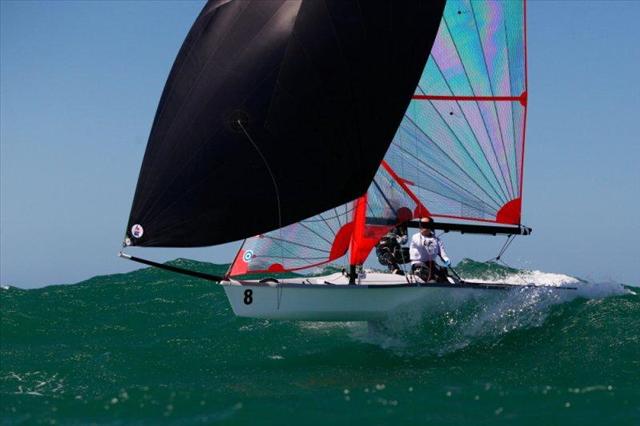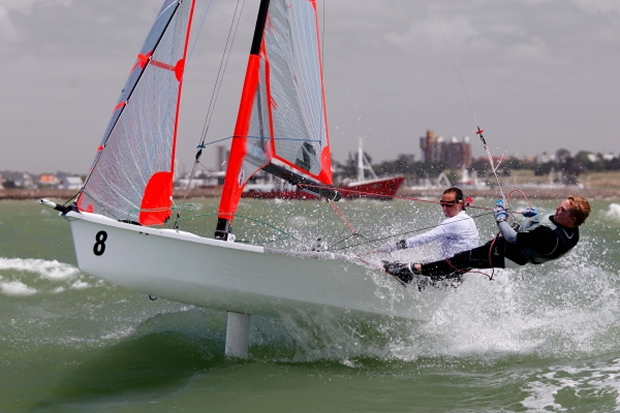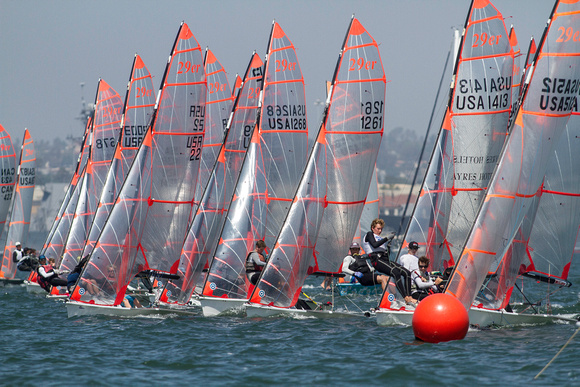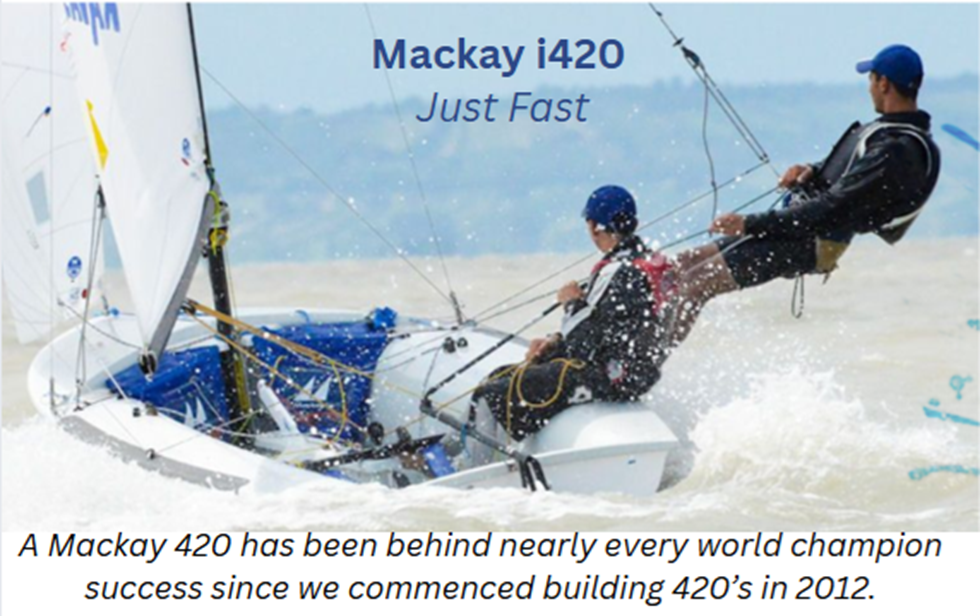Youth sailing traditionally has been in dinghies designed 60 years ago with very few updates or improvements. The 29er changed all that when it was introduced in 1998 by acclaimed naval architect Julian Bethwaite. A high performance skiff aimed at young sailors, the 29er represents the future of the sport.
The Boat: The Next Big Thing
Skiff sailing has been popular down under in Australia and New Zealand for years in boats such as the International 14, Cherub Skuff and Aussie 18. These boats differ from the traditional dinghy hull design (such as 470, 5o5, etc.) having a very narrow bow entry, narrow hull with a flat exit and often-large wings that extend off the main hull. Skiffs have a large sail area for the size of the hull and rely on crew placement on a trapeze (sometimes skipper as well) to keep the boat flat. They will plane very quickly and can reach high speeds.
The 29er was developed from the 49er class as a youth trainer. It replaced the Laser 2 at ISAF Youth Worlds when it was introduced. Hull weight is a measly 150lbs, absolutely nothing for a 14’ boat. It gets its 5’7” width from the wings off the center hull. Sail area is 142 square feet for main and jib with a fractional asymmetrical spinnaker adding another 181 square feet of sail. The jib is self tacking, leaving the crew to manage main trim upwind.
Minimal hull weight is achieved by a fiberglass-reinforced polyester (GRP) and closed cell foam sandwich. The mast is constructed in three parts; aluminum mid and bottom sections and a lightweight fiberglass tip to reduce weight and increase mast flexion at the tip. Sails are made from Mylar and spinnaker from Nylon.
Former college sailor and current 29er sailor Dan Goldman loves the competition and speed of the 29er, “The boat is fun to sail because it is fast and challenging. The most challenging part [of 29er sailing] is keeping the boat upright in 20+ knots [of wind].”
Set Up and Sailing: Fast and Wet
The 29er is easily set up by two people and can go from the trailer to the water in a matter of minutes. The rig is light and tall; to step it the shroud adjusters are pinned to the chain plates, the mast butt is inserted into the mast step, and the mast is pulled forward and upright using the trapeze wires. From here, the boom, vang and control lines are connected and run through the appropriate blocks. A reliable set up guide can be found here (http://www.29er.org/images/stories/pdf/29er%20rigging_manual.pdf).
Weight position in the boat is important in all wind conditions. In light air, weight forward will reduce the amount of drag in the stern and cavitation off the back of the boat. As wind speed increases, moving weight back gets the bow out of waves and encourages the boat to plane. The 29er is a true skiff and likes to go fast; thusly it should be sailed fast. Upwind, stalling the boat by luffing in puffs or pinching will stop the boat quickly and should be avoided.
Because of the self-tacking jib, skipper/crew responsibilities are slightly different from a traditional double-handed boat. Sailing upwind the 29er skipper drives the boat and adjusts jib as needed and the crew trims main. Off the breeze the crew trims the gennaker and the skipper trims the main and drives. When sailing off the breeze the main should be kept trimmed to the back corner of the wing. This supports the mast and allows the boat to power up as apparent wind moves forward.
Class Association: International Acclaim
As an international class, the 29er benefits from support of organizing bodies around the world. The 2014 World Championships at CORK in Kingston, Ontario this year saw over 100 boats in three fleets from yacht clubs around the world. Class support for this boat has been huge; as the trainer for the Olympic 49er class, athlete development directly affects national team programs.
Why Sail?
The 29er brings to the table something few other, if any, classes that offer youth sailors competitive international events, fast technical sailing, and support from a large organizing body. “Fast is fun, and competing against the best in the world (C420 is NA only) is even more fun,” said Goldman. It is true, fast is fun and so is international competition. If the C420 circuit is getting a little stale, or you simply want to take a spin on a higher performance boat, the 29er is tomorrow’s youth trainer, today.
29er sailboat
29er
More of an advanced boat, the 29er is a fast skiff designed by Julian Bethwaite and first produced in 1998, and is the little sister to the 49er. It is targeted at youth, especially those training to sail the larger 49er. It has a single trapeze and an asymmetric spinnaker much like that of the 49er (although smaller). The popular boat is considered a more rapid alternative to the laser vdinghy and has an international racing class devoted to it.
loa 14’5”
beam 5’7”
sail area 142 ft²
spinnaker area 181 ft²
hull weight 198
crew 2
# of boats built not known
active US fleets MD, FL, CA, MA, CT, RI.
Class website:
http://www.29er.org/
Check our our One Design Profile and write-up on the 29er!
Browse our extensive list of one design classes below! Want to buy/sell a boat? Visit our popular Marketplace and find, or sell, your boat!! We also have a great and growing list of One-Design Class Profiles, so feel free to check them out too!! If you would like to add your favorite one design class, please do not hesitate contact us. Enjoy!






